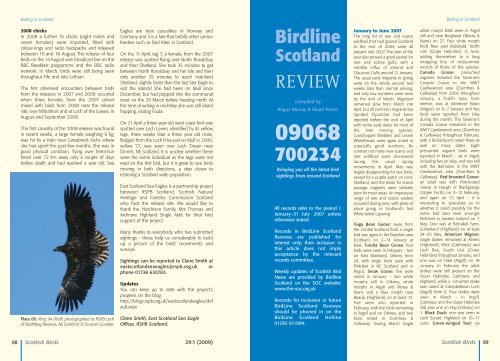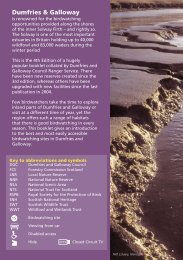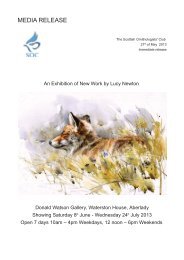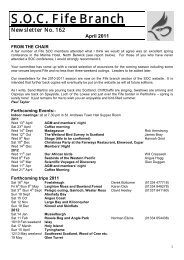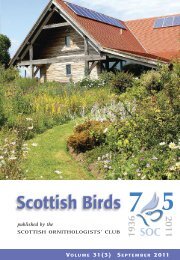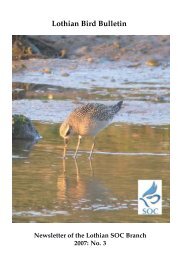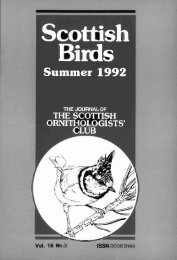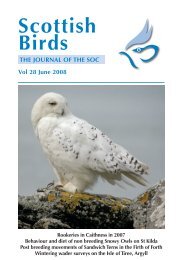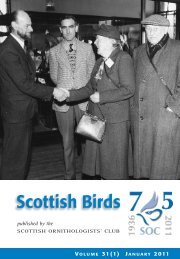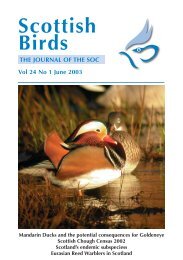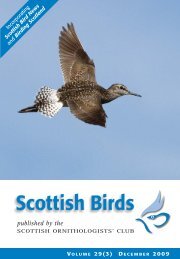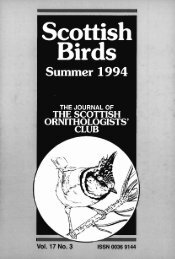*SCOTTISH BIRDS (29) TXT AW - The Scottish Ornithologists' Club
*SCOTTISH BIRDS (29) TXT AW - The Scottish Ornithologists' Club
*SCOTTISH BIRDS (29) TXT AW - The Scottish Ornithologists' Club
Create successful ePaper yourself
Turn your PDF publications into a flip-book with our unique Google optimized e-Paper software.
Birding in ScotlandBirding in Scotland2008 chicksIn 2008 a further 15 chicks (eight males andseven females) were imported, fitted withcolour-rings and radio backpacks and releasedbetween 10 and 18 August. <strong>The</strong> release of fourbirds on the 14 August was broadcast live on theBBC Breakfast programme and the BBC radionetwork. In March, birds were still being seenthroughout Fife and into Lothian.<strong>The</strong> first observed encounters between birdsfrom the releases in 2007 and 2008 occurredwhen three females from the 2007 cohortmixed with birds from 2008 near the releasesite, over Milnathort and at Loch of the Lowes, inAugust and September 2008.<strong>The</strong> first casualty of the 2008 release was foundin recent weeks, a large female weighing 6 kg,was hit by a train near Carsebreck lochs whereshe had spent the past few months. She was ingood physical condition, flying over Tentsmuirforest over 72 km away only a couple of daysbefore death and had reached a year old. SeaPlate 80. Ring 94 (Ralf) photographed at RSPB Lochof Strathbeg Reserve, NE Scotland © Duncan Goulder.Eagles are train casualties in Norway andGermany and it is a fate that befalls other carrionfeeders such as Red Kites in Scotland.On the 11 April, tag 7, a female, from the 2007release was spotted flying over North Ronaldsayand then Shetland. She took 35 minutes to getbetween North Ronaldsay and Fair Isle and thenonly another 35 minutes to reach mainlandShetland, slightly faster than the last Sea Eagle tovisit the islands! She had been on Mull sinceDecember, but had popped into the communalroost on the <strong>29</strong> March before heading north. Atthe time of writing in mid-May she was still islandhopping, visiting Foula.On 21 April a three year old west coast bird wasspotted over Loch Leven, identified by its yellowtags, three weeks later a three year old male,fledged from the Loch Frisa pair on Mull in 2006,yellow ‘O’, was seen over Loch Davan nearDinnet, NE Scotland. It is unclear whether thesewere the same individual as the tags were notread on the first bird, but it is great to see birdsmoving in both directions, a step closer torestoring a Scotland wide population.East Scotland Sea Eagles is a partnership projectbetween RSPB Scotland, <strong>Scottish</strong> NaturalHeritage and Forestry Commission Scotlandwho host the release site. We would like tothank the Hutchison Family, Mrs Thomas andArdmore Highland Single Malt for their kindsupport of the project.Many thanks to everybody who has submittedsightings - these help us considerably to buildup a picture of the birds’ movements andsurvival.Sightings can be reported to Claire Smith ateastscotlandseaeagles@rspb.org.uk orphone 01738 630783.UpdatesYou can keep up to date with the project’sprogress on the blog:http://blogs.rspb.org.uk/eastscotlandeagles/default.aspxClaire Smith, East Scotland Sea EagleOfficer, RSPB Scotland.BirdlineScotlandREVIEWcompiled byAngus Murray & Stuart Rivers09068700234Bringing you all the latest birdsightings from around ScotlandAll records refer to the period 1January–31 July 2007 unlessotherwise stated.Records in BirdLine ScotlandReviews are published forinterest only; their inclusion inthis article does not implyacceptance by the relevantrecords committee.Weekly updates of <strong>Scottish</strong> BirdNews are provided by BirdlineScotland on the SOC website:www.the-soc.org.ukRecords for inclusion in futureBirdLine Scotland Reviewsshould be phoned in on theBirdLine Scotland Hotline01<strong>29</strong>2 611994.January to June 2007<strong>The</strong> long list of rare and scarcewildfowl that had graced Scotlandat the end of 2006 were allpresent into 2007. <strong>The</strong> start of theyear also proved a good period forrare and scarce gulls, with anotable influx of Iceland andGlaucous Gulls around 21 January.<strong>The</strong> usual early migrants in springwere on the whole around twoweeks later than normal arriving,and only low numbers were seenby the end of March. Migrationremained slow from March intoApril, but all common migrants barSpotted Flycatcher had beenreported before the end of Aprilwith some early dates for most ofthe later moving species.Grasshopper Warblers and LesserWhitethroats were again noted inespecially good numbers. Bycontrast not many new scarce andrare wildfowl were discoveredduring the usual springmovements in April. May waslargely disappointing for rare birds,except for a purple patch on Unst,Shetland, and the totals for scarcepassage migrants were similarlypoor for most areas. An impressiverange of rare and scarce wadersoccurred during June, with pride ofplace going to Scotland’s firstWhite-tailed Lapwing.Taiga Bean Goose: away fromthe Central Scotland flock a singlebird was again in the Bavelaw area(Lothian) on 2–14 January atleast. Tundra Bean Goose: fourbirds were seen in February - twoon East Mainland, Orkney from24, with single birds seen withPink-feet in NE Scotland and inAngus. Snow Goose: five werenoted in January - two whitemorphs still in Orkney, whitemorphs in Argyll and Moray &Nairn, and a blue morph nearBeauly (Highland) on at least 13.Five were also reported inFebruary, with the birds remainingin Argyll and on Orkney, and twobirds noted in Dumfries &Galloway. During March singlewhite morph birds were in Argyllstill and near Burghead (Moray &Nairn) on 27. Four white morphbirds flew past Balranald, NorthUist (Outer Hebrides) in June,adding themselves to a longintriguing line of midsummerrecords of flocks of this species.Canada Goose: presumedvagrants included the Taverner’sCanada Goose in the WWTCaerlaverock area (Dumfries &Galloway) from 2006 throughoutJanuary, a Todd’s type, forminterior, was at Montrose Basin(Angus) on 6–7 January and fivebirds were reported from Islayduring the month. <strong>The</strong> Taverner’sCanada Goose remained in theWWT Caerlaverock area (Dumfries& Galloway) throughout February,with a Richardson’s noted there aswell on many dates. Eightpresumed vagrant birds werereported in March - six in Argyll,including five on Islay, and two stillwith the Barnacles in the WWTCaerlaverock area (Dumfries &Galloway). Red-breasted Goose:an adult was with Pink-footedGeese at Haugh of Blackgrange(Upper Forth) on 3–12 February,and again on 15 April - it isinteresting to speculate as towhether it could possibly be thesame bird later seen amongstPink-feet in eastern Iceland on 7May. One was at Balnakeil Farm,Sutherland (Highland) on at least24–25 May. American Wigeon:single drakes remained at Alness(Highland), Wick (Caithness) andLoch Bee, South Uist (OuterHebrides) throughout January, andone was on Tiree (Argyll) on 18January. In February the adultdrakes were still present on theOuter Hebrides, Caithness andHighland, while a 1st-winter drakewas noted at Campbeltown Loch(Argyll) from 6. Four drakes wereseen in March - in Argyll,Caithness and the Outer Hebridesstill, plus one on Hoy (Orkney) on1. Black Duck: one was seen atLoch Sunart, Highland on 16–17June. Green-winged Teal: six88<strong>Scottish</strong> Birds <strong>29</strong>:1 (2009) <strong>29</strong>:1 (2009)<strong>Scottish</strong> Birds 89


